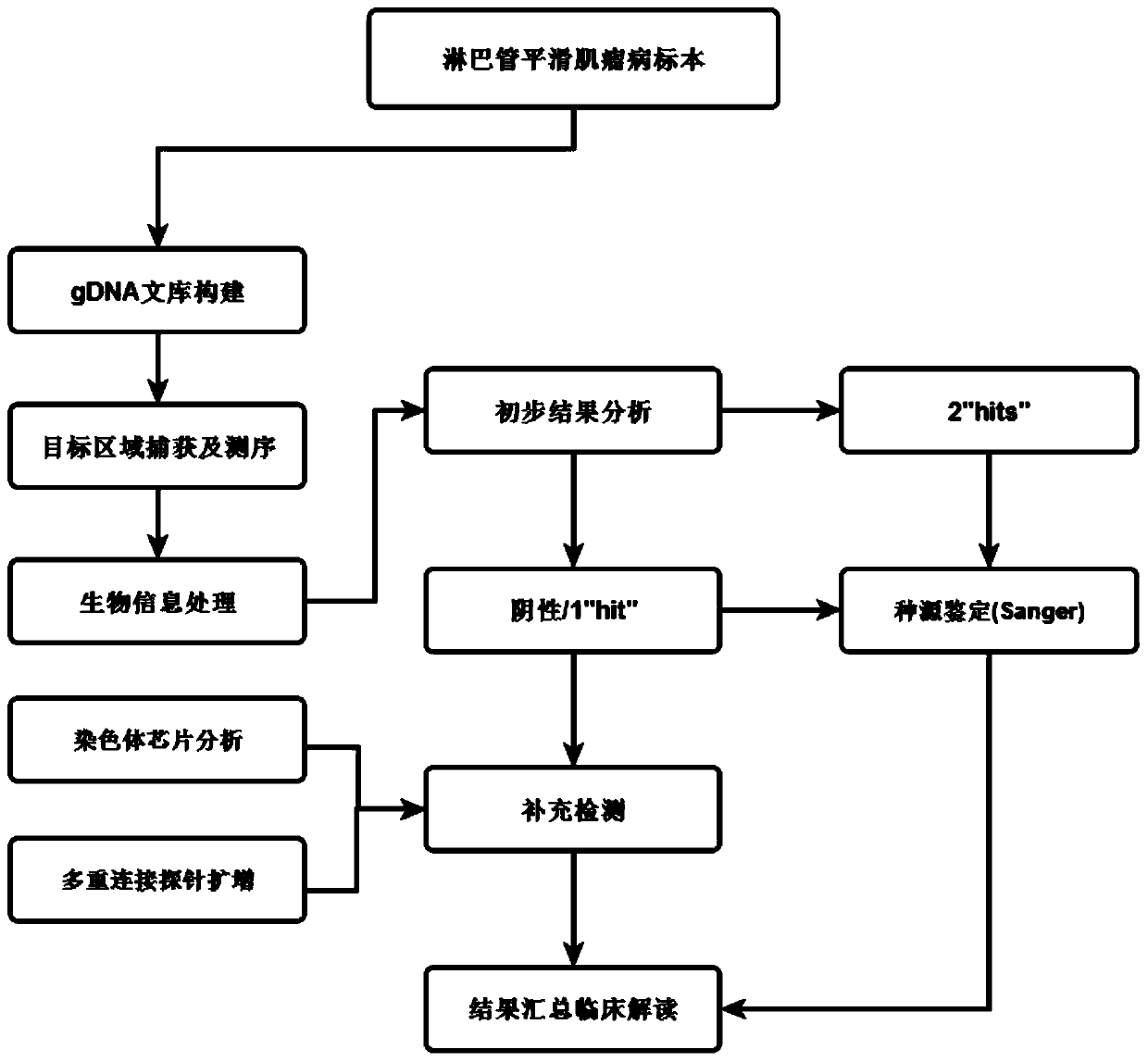Lymphangiomyoma joint detection method and application thereof
A technique for leiomyoma and combined detection, applied in the field of combined detection of lymphangioleiomyomatosis, can solve problems such as unclear root causes, and achieve the effect of improving positive
- Summary
- Abstract
- Description
- Claims
- Application Information
AI Technical Summary
Problems solved by technology
Method used
Image
Examples
Embodiment 1
[0045] as per figure 1 In the multi-method combined detection scheme for lymphangioleiomyomatosis shown, the following detections are performed on lymphangioleiomyomatosis specimens.
[0046] 1. Using probes for liquid phase capture targeted sequencing (Target Capture Sequencing, NGS);
[0047] 1. Design Panel
[0048] The shingled design was performed on the entire exon coding regions of TSC1 and TSC2 genes that are highly related to LAM, and the probes of TSC1 and TSC2 genes were designed as follows: figure 1 As indicated, to ensure at least 2-fold coverage of the target regions of the two genes, each probe is 100 bp long.
[0049] At the same time, refer to COSMIC, TCGA and other databases, combined with the latest NCCN guidelines / consensus, screen the proto-cancer and tumor suppressor genes that are closely related to the occurrence and development of solid tumors, and design probes according to conventional methods, that is, the probes are connected at the ends. Perfor...
Embodiment 2
[0172] The method of Example 1 was used to carry out the LAM joint detection research.
[0173] 1. Comparison of single detection method and joint detection method.
[0174] In this study, a total of 61 patients with LAM were enrolled, and a single detection method and the method in Example 1 were used for detection at the same time.
[0175] A single detection method is a method that only uses NGS targeted sequencing.
[0176] The result is as Figure 3-4 shown, where image 3 It is the detection ratio of variant sites using different detection methods, where NGS means liquid phase capture targeted sequencing, chromosome microarray analysis, and MLPA means multiple ligation probe amplification detection. The above results show that through multi-method joint detection, SNV, INDEL, CNV, LOH and other variant types can be fully output for LAM patient samples. If a single NGS detection method is used, 12.8% of the variants will be lost
[0177] Using a single detection metho...
Embodiment 3
[0185] An example of LAM joint detection is performed using the method of Embodiment 1.
[0186] 1. Sample source
[0187] The sample came from a fixed tissue specimen from the Respiratory Medicine Department of a tertiary hospital in Guangzhou, and the clinical diagnosis was S-LAM.
[0188] 2. Detection method and result
[0189] 1. Using probes for liquid phase capture targeted sequencing (Target Capture Sequencing, NGS)
[0190] Sequencing results showed that the sample had a single site mutation, TSC2: NM_000548.4:c.3412C>T(p.Arg1138*), and the mutation frequency was 50.9%.
[0191] 2. Chromosome microarray analysis and multiple junction probe amplification
[0192] According to the method of Example 1, the chromosome chip analysis method was used for supplementary detection, and the results showed that the patient found a loss of heterozygosity (LOH) mutation in the TSC2 gene: arr 16p13.3p11.2(83886_30809063)x2mos hmz, the variation size is 30.73Mb, its LOH fragment i...
PUM
 Login to View More
Login to View More Abstract
Description
Claims
Application Information
 Login to View More
Login to View More - R&D
- Intellectual Property
- Life Sciences
- Materials
- Tech Scout
- Unparalleled Data Quality
- Higher Quality Content
- 60% Fewer Hallucinations
Browse by: Latest US Patents, China's latest patents, Technical Efficacy Thesaurus, Application Domain, Technology Topic, Popular Technical Reports.
© 2025 PatSnap. All rights reserved.Legal|Privacy policy|Modern Slavery Act Transparency Statement|Sitemap|About US| Contact US: help@patsnap.com



